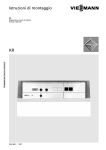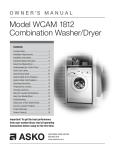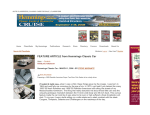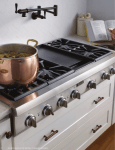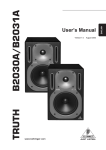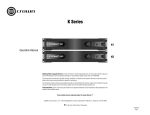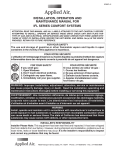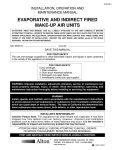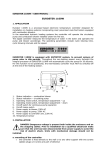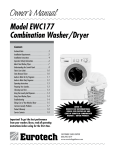Download KN SERIES MASTER SPECIFICATION
Transcript
KNSP4-5 KN SERIES MASTER SPECIFICATION SECTION 23 52 16 – CONDENSING HIGH EFFICIENCY CAST IRON HYDROTHERM KN-SERIES BOILERS PART 1 - GENERAL 1.1 A. 1.2 RELATED DOCUMENTS Drawings and general provisions of the Contract, including General and Supplementary Conditions and Division 1 Specification Sections, apply to this Section. SUMMARY A. This Section includes gas-fired, condensing cast-iron boilers for heating hot water. B. Related Sections include the following: 1. Division 23 Section “Breechings, Chimneys, and Stacks” for connections to breechings, chimneys, and stacks. 2. Division 23 Section “Feedwater Equipment” for connections to condensate and feedwater system. 3. Division 23 Sections for control wiring for automatic temperature control. 1.3 SUBMITTALS A. Product Data: Include rated capacities; shipping, installed, and operating weights; furnished specialties; and accessories for each model indicated. B. Shop Drawings: Detail equipment assemblies and indicate dimensions, required clearances, and method of field assembly, components, and location and size of each field connection. 1. Wiring Diagrams: Detail wiring for power, signal, and control systems and differentiate between manufacturer-installed and field-installed wiring. C. Source Quality Control Tests and Inspection Reports: Indicate and interpret test results for compliance with performance requirements before shipping. D. Field Test Reports: Indicate and interpret test results for compliance with performance requirements. E. Maintenance Data: Include in the maintenance manuals specified in Division 1. Include parts list, maintenance guide, and wiring diagrams for each boiler. CONDENSING BOILERS 23 52 16 1 KN SERIES MASTER SPECIFICATION 1.4 A. QUALITY ASSURANCE Listing and Labeling: Provide electrically operated components specified in this Section that are listed and labeled. 1. The Terms “Listed” and “Labeled”: As defined in NFPA 70, Article 100. 2. Listing and Labeling Agency Qualifications: A “Nationally Recognized Testing Laboratory” as defined in OSHA Regulation 1910.7. B. ASME Compliance: Boilers shall bear ASME “H” stamp and be National-Board listed. C. FM Compliance: Control devices and control sequences according to requirements of FM. D. Comply with NFPA 70 for electrical components and installation. E. IRI Compliance: Control devices and control sequences according to requirements of IRI (GE GAP). F. CSD-1 G. SCAQMD Rule 1146.2 for low NOx equipment H. ARRA Compliance: Total overall percentage of US origin materials used in the manufacturing of the boilers shall be 100% and 100% assembly of these products shall be completed in the US – Buy American compliant. 1.5 A. 1.6 COORDINATION Coordinate size and location of concrete bases. Concrete, reinforcement, and formwork requirements are specified in Division 3 Section “Cast-in-Place Concrete.” WARRANTY A. General Warranty: The special warranty specified in this Article shall not deprive the Owner of other rights the Owner may have under other provisions of the Contract Documents and shall be in addition to, and run concurrent with, other warranties made by the Contractor under requirements of the Contract Documents. Installing contractor shall provide one year of warranty parts and labor. B. Special Warranty: Submit a written warranty, executed by the contractor for the heat exchanger. 1. Warranty Period: Manufacturer’s standard, but not less than 10 years from date of Substantial Completion on the heat exchanger. Warranty shall be non-prorated and not limited to thermal shock. Additional 21-year thermal shock warranty on heat exchanger. CONDENSING BOILERS 23 52 16 2 KN SERIES MASTER SPECIFICATION PART 2 - PRODUCTS 2.1 MANUFACTURERS A. Available Manufacturers: Manufacturer shall be a company specializing in manufacturing the products specified in this section with minimum five (5) years experience. Subject to compliance with requirements, manufacturers offering boilers that may be incorporated into the Work include, but are not limited to, the following: B. Design: Boilers shall be CSA design certified as a condensing boiler. Boilers shall be designed for a minimum of 5:1 continuous turn down with constant CO2 over the turndown range. The boiler shall operate with natural gas and have a CSA International certified input rating as noted on the drawings, and a thermal efficiency rating up to 99% at minimum input. The boiler shall be symmetrically airfuel coupled such that changes in combustion air flow or flue flows affect the BTUH input without affecting combustion quality. The boiler will automatically adjust input for altitude and temperature induced changes in air density. The boiler will use a proven pilot interrupted spark ignition system. The boiler shall use a UL approved flame safeguard ignition control system using UV detection flame sensing. The UV detector shall be air cooled to prevent condensate formation and so designed as to prevent misalignment. The design shall provide for silent burner ignition and operation. The boiler shall be down fired counter flow such that formed condensate always moves toward a cooler zone to prevent re-evaporation. An aluminum corrosion resistant condensate drain designed to prevent pooling and accessible condensate trap shall be provided. In some jurisdictions, a means of neutralizing the condensate Ph levels may be required. Boiler shall be able to vent a horizontal distance of 80 (120 for KN-30) equivalent feet with a vent diameter equivalent to the combustion chamber outlet diameter. C. Service Access: The boilers shall be provided with access covers for easily accessing all serviceable components. The boilers shall not be manufactured with large enclosures, which are difficult to remove and reinstall. All accesses must seal completely as not to disrupt the sealed combustion process. All components must be accessible and able to adjust with the removal of a single cover or cabinet component. D. Indicating lights: Each boiler shall include a diagnostic control panel with a full text display indicating the condition of all interlocks and the BTUH input percentage. Access to the controls shall be through a completely removable cover leaving diagnostic panel intact and not disrupted. E. Manufacturers: Hydrotherm (a Mestek Company) is the basis of design. Listed acceptable manufacturers shall be subject to compliance with requirements. Provide boilers by one of the following: 1. Viessmann Vertomat 2. Cleaver Brooks – Clear Fire 3. Patterson Kelley - Mach CONDENSING BOILERS 23 52 16 3 KN SERIES MASTER SPECIFICATION 2.2 COMPONENTS A. Combustion Chamber: The combustion chamber shall be constructed of cast-iron. It shall be a down-fired design utilizing lightweight refractory around the burner housing. B. Heat Exchanger: Boilers shall be a cast iron sectional unit designed for pressure firing and shall be constructed and tested for 100 P.S.I water working pressure, in accordance with the A.S.M.E. Section IV Rules for the Construction of Heating Boilers. Individual sections will have been subjected to a hydrostatic pressure test of 250 PSIG at the factory before shipment and they shall be marked, stamped or cast with the A.S.M.E. Code symbol. Boilers with less than 250-psi pressure test will not be acceptable for this project. The sections shall be of a down fired counter flow single-pass design. Water ports will be sealed with steel push nipple connectors. The sections will be fully machined for metal to metal sealing of the gas side surfaces. The design will provide for equal temperature rise through all sections. The iron shall have a minimum thickness of ¼". The heat exchanger design should have no limitations on temperature rise or restrictions to inlet water temperature and a Cv of 60 (KN-6), 100 (KN-10), 190 (KN-20) and 278 (KN-30). C. Jackets: Stainless Steel (KN-6, 10, 20, 30). D. Gas Burner: The burner shall be metal fiber mesh construction, allowing high turndown of the fuel-air mixture. The burner flame shall burn horizontally and be of the pre-mix type with a forced draft fan. Burner shall fire to provide equal distribution of heat throughout the entire heat exchanger. The burner shall be easily removed for maintenance without the disruption of any other major component of the boiler. A window view port shall be provided for visual inspection of the boiler during firing. The gas distribution components and burner shall be enclosed with a castaluminum housing. E. Ignition components: The ignition hardware shall consist of Alumina ceramic insulated ignition electrodes and UV sensing tube permanently arranged to ensure proper ignition electrode and UV alignment. F. Rated Capacity: The boiler shall be capable of operating at rated capacity with pressures as low as 2" (3" for KN-30) W.C. at the inlet to the burner gas valve. G. The burner shall be capable of 99% efficiency without exceeding a NOx reading above 11ppm. H. The burner and gas train shall be provided with the following trim and features: 1. Burner Firing: Full modulation with 5:1 turndown @ Continuous CO2 2. Burner Ignition: Intermittent spark 3. Safety Controls: Energize ignition, limit time for establishing flame, prevent opening of gas valve until pilot flame is proven, stop gas flow on ignition failure, and allow gas valve to open. 4. Flue-Gas Collector: Enclosed combustion chamber with integral combustion-air blower and single venting connection. 5. Gas Train: Manual ball type gas valves (2), main gas valve (solenoid), manual test and check valves, pilot gas pressure regulator, and automatic pilot gas valve. All components to be factory mounted and CSD-1 compliant. CONDENSING BOILERS 23 52 16 4 KN SERIES MASTER SPECIFICATION 6. Safety Devices: Low gas pressure switch, air-flow switch, and blocked flue detection switch, low water cutoff (manual reset), high temperature manual reset. All safeties to be factory mounted. 7. Individual gas regulator provided by factory, shipped loose for field installation, one per boiler (KN-6, 10, 20). I. 2.3 A. Optional Dual Fuel Capacity: (KN-20 only) if/when scheduled the boiler shall include a gas train and combustion system capable of dual fuel operation. The dual fuel boiler shall be able to operate on both natural gas and propane. The boiler efficiency and turndown shall remain constant regardless of fuel selection. The dual fuel combustion system shall incorporate individual natural gas and propane gas trains, which will meet all applicable national and local codes and standards. The dual fuel system shall have a fuel selector switch for automatic fuel changeover. There shall be no manual fuel changeover devices incorporated with the dual fuel system. The switching mechanism shall be designed so there is no possibility of both fuels flowing simultaneously. The boiler shall be commissioned and calibrated to run on both fuel sources at start-up. No additional re-calibration shall be required when switching fuel systems until the next annual service date for the boiler. BOILER TRIM Controls: The boiler control package shall be a MTI Heat-Net or equivalent, integrated boiler management system. The control system must be integral to each boiler, creating a control network that eliminates the need for a “wall mount” stand-alone boiler system control. Additional stand-alone control panels, independent of a Building Management System (BMS), shall not be allowed to operate the boiler network. The Heat-Net control shall be capable of operating in the following ways: 1. As a stand-alone boiler control system using the Heat-Net protocol, with one “Master” and multiple “Member” units. 2. As a boiler network, enabled by a Building Management System (BMS), using the Heat-Net protocol, with one “Master” and multiple “Member” units. 3. As “Member” boilers to a Building Management System (BMS) with multiple input control methods. 4. Failsafe mode – When a Building Automation System is controlling set point, if communications are lost, the boiler/system will run off the Local set point. 5. Adaptive Modulation – Lowers the modulation rate of all currently operating boilers before a newly added boiler enters operation. 6. Priority Firing – Allows mixing of condensing, non-condensing base-load and/or other combination of (2) functional boiler types utilizing (2) priority levels. 7. Available priority start/stop qualifiers shall be done using any combination of: A) Modulation Percentage B) Outdoor Air Temperature or C) Return Water Temperature. 8. Base Loading – Provides the ability to control (1) base load boiler with enable/disable and 4-20mA modulating signal (if required). CONDENSING BOILERS 23 52 16 5 KN SERIES MASTER SPECIFICATION MASTER: A boiler becomes a Master when a resistance type 10K sensor is connected to the J10 “SYS/ DHW HEADER” terminals. The sensor shall be auto detected. The Master senses and controls the header/loop temperature utilizing a system setpoint. It uses any boilers it finds “Heat-Net Members” or those defined in the control setup menus to accomplish this. The “Master” shall also have the option of monitoring Outside Air Temperature “OA” to provide full outdoor air reset functionality. Only one master shall be allowed in the boiler network. When operating as a “Master”, the Heat-Net control provides a stand-alone method using a PID algorithm to regulate water temperature. The algorithm allows a single boiler “Master” or multiple “Master + Member” boilers in a network of up to 16 total boilers. The control algorithm is based upon a control band, at the center of which is the setpoint. While below the control band, boilers are staged on and modulated up until the control band is entered. Once in the control band, modulation is used to maintain setpoint. Optimized system efficiency is always accomplished by setting the Modulation Maximum “Mod-Max” setting to exploit each boiler in the network’s inverse efficiency curve. The control shall operate so that the maximum number of boilers required, operate at their lowest inputs until all boilers are firing. Once all boilers are firing, the modulation clamp is removed and all boilers are allowed to fire above this clamped percentage up to 100%. This “boiler efficiency” clamp is defaulted to 80% and thus limits all the boilers individual outputs to 80% until the last boiler fires. The 80% default must be field adjustable for varying operating conditions. All boilers modulate up and down together always at the same modulation rate. Boilers are shut down only when the top of the band is breached, or before the top of the band, if the control anticipates that there is a light load. Timers shall also be included in each control in the network to prevent any boiler from short cycling. MEMBER: Additional boilers in the network always default to the role of member. The lack of sensors connected to the J10 terminals “SYS/DHW Header” on each additional boiler shall ensure this. Each “Member” shall sense its supply outlet water temperature and modulate based on signals from a Building Management System (BMS) or “Master” boiler. When operating as a member, starting, stopping, and firing rate shall also be controlled by the “BMS” or “Master” boiler. When using the Heat-Net protocol, the system setpoint shall be sent from the “Master”, along with the modulation value to control firing rate. It also receives its command to start or stop over the Heat-Net cable. Each “Member” will continuously monitor its supply outlet temperature against its operating limit. If the supply temperature approaches the operating limit temperature (adjustable), the boilers input control rate is limited and its modulation value decreases to minimize short cycling. If the operating limit is exceeded, the boiler shall shut off. Each Heat-Net control in the boiler network shall have the following standard features: 1. Digital Communications Control. A. Boiler to Boiler: Heat-Net B. Building Management System (BMS): MODBUS standard protocol. (BACnet and LONWORKS optional protocols) CONDENSING BOILERS 23 52 16 6 KN SERIES MASTER SPECIFICATION 2. Analog 4:20 and 0-10vdc also supported. 3. Distributed control using Heat-Net protocol for up to 16 total boilers. 4. System/Boiler operating status in English text display. 5. Interlock, Event, and System logging with a time stamp. 6. Advanced PID algorithm optimized for specific boilers (KN-Series). 7. Four dedicated temperature sensor inputs for: Outside Air Temperature, Supply (Outlet Temperature, Return Temperature (Inlet), and Header Temperature. 8. Automatically detects the optional temperature sensors on start up. 9. Menu driven calibration and setup menus with a bright 4-line Vacuum Fluorescent Display. 10. (8) Dedicated 24vac interlock monitors and 8 dedicated 120vac system monitors used for diagnostics and providing feedback of faults and system status. 11. Multiple boiler pump or motorized boiler valve control modes. 12. Combustion Air Damper control with proof time. 13. Optional USB/RS485 network plug-in to allow firmware updates or custom configurations. 14. Optional BACnet and LONWORKS interface. 15. Alarm contacts. 16. Runtime hours. 17. Outdoor Air Reset with programmable ratio. 18. Time of Day clock to provide up to four (4) night setback temperatures. 19. Failsafe mode when a Building Management System (BMS) is controlling setpoint. If communications is lost, the boiler/system shall run off the Local Setpoint. 20. Support for domestic hot water (DHW) using a 10k sensor or a dry contact input from a tank thermostat and a domestic hot water relay (pump/valve) 21. Continuous Daily Runtime Restart feature that monitors the runtime of each boiler and if any in the network have exceeded 24 hours of continuous runtime, the boiler is restarted to protect the UV flame scanner. 22. Allows for selection of any boiler in the network to act as Lead Boiler. CONDENSING BOILERS 23 52 16 7 KN SERIES MASTER SPECIFICATION 23. Adaptive Modulation feature in which the Master boiler adjusts the system modulation rate to a lower value when a new boiler in the network is started to compensate for the added BTU’s to the system. Once the newly added boiler fires and the adjustable timer expire, the Master resumes control of the system modulation to maintain setpoint temperature. 24. Priority firing – Allows mixing of condensing and non-condensing, base load and/or other combination of (2) functional boiler types utilizing (2) priority levels. 25. Available priority start/stop qualifiers shall be done using any combination of: A) modulation percentage B) outdoor air temperature (or) C) return water temperature. 26. Base Loading – Provides the ability to control (1) base load boiler with enable/disable and 4-20mA modulating signal (if required). B. Safety-Relief Valve: ASME rated, factory set to protect boiler and piping as per schedule/drawings. 100 psi maximum allowable working pressure C. Gauge: Combination water pressure and temperature shipped factory installed. LCD outlet temperature readout to be an integral part of the front boiler control panel display to allow for consistent easy monitoring of temperatures factory mounted and wired. D. Burner Controls: Boiler shall be provided with a Honeywell RM7800 series digital flame safe guard with UV rectification. The flame safe guard shall be capable of both pre and post purge cycles. E. High Limit: Temperature control with manual-reset limits boiler water temperature in series with the operating control. High Limit shall be factory mounted and sense the outlet temperature of the boiler through a dry well. F. PROVIDE THE FOLLOWING STANDARD TRIM: 1. Aluminum Condensate Receiver Pan 2. Low Air Pressure Switch 3. Blocked Flue Detection Switch 4. Modulation Control 5. Temperature/Pressure Gauge 6. Manual Reset High Limit (CSD-1 Factory Mounted and Wired) 7. Low Gas Pressure Safety Switch 8. Low Water Cutoff with Manual Reset (CSD-1 Factory mounted and wired) 9. Gas Pressure Regulator to provide 4" Incoming Pressure to Main Gas Valve – Shipped Loose for Field Installation (KN-6, 10, 20). 10. Air inlet filter CONDENSING BOILERS 23 52 16 8 KN SERIES MASTER SPECIFICATION 11. Supply Outlet Temperature Display 12. Full Digital Text Display for all Boiler Series of Operation and Failures 13. Air Inlet Filter 14. Variable Frequency Drive (not required on KN-30) and Combustion Air Fan with Safety Interlock 15. Condensate Drain G. PROVIDE THE FOLLOWING JOB SPECIFIC TRIM AND FEATURES: 1. High Gas Pressure Switch and Valve Proving Switch for IRI Compliant Gas Train 2. Flow switch mounted and wired 3. Isolation valve wiring with mounted J box in rear of boiler. 4. Pump relay mounted and wired. 5. 460-600 volt 1 phase power (KN-20) 6. 460-600 volt 3 phase power (KN-30) 2.4 MOTORS A. Refer to Division 15 Section "Motors" for factory-installed motors. B. Boiler Blower Motor: Blower motor shall be externally mounted for ease of service. There shall be no requirement to remove covers or gas train components to remove the blower motor. The KN-6 Blower shall be .5 HP and FLA not to exceed 5 Amps. The KN-10 Blower shall be .5 HP and FLA not to exceed 8 Amps. The KN-20 Blower shall be 1 HP and FLA not to exceed 11 Amps. The KN-30 Blower shall be 3 HP and FLA not to exceed 14 Amps. 2.5 SOURCE QUALITY CONTROL A. Test and inspect boilers according to the ASME Boiler and Pressure Vessel Code, Section IV. Boilers shall be test fired in the factory with a report attached permanently to the exterior cabinet of the boiler for field reference. PART 3 - EXECUTION 3.1 A. EXAMINATION Examine area to receive boiler for compliance with requirements for installation tolerances and other conditions affecting boiler performance. Do not proceed with installation until unsatisfactory conditions have been corrected. CONDENSING BOILERS 23 52 16 9 KN SERIES MASTER SPECIFICATION 3.2 INSTALLATION A. Install boilers level and plumb, according to manufacturer’s written instructions and referenced standards. B. Install gas-fired boilers according to NFPA 54. C. Support boilers on a minimum 4-inch- (100-mm-) thick concrete base, 4 inches (100 mm) larger on each side than base of unit. D. Install electrical devices furnished with boiler, but not specified to be factory mounted. 3.3 CONNECTIONS A. Connect gas piping and individual regulator, full size, to boiler gas-train inlet with union. B. Connect hot water piping to supply and return boiler tappings with shutoff valve and union or flange at each connection. C. Install piping from safety-relief valves to nearest floor drain. D. Connect breeching to boiler outlet, full size of outlet. The boiler shall operate under positive (Category IV) or negative (Category II) stack pressure. Vent material must be listed AL29-4C Stainless Double Wall Stack for condensing appliances. E. Electrical: Comply with applicable requirements in Division 16 Sections. F. Ground equipment. 1. Tighten electrical connectors and terminals according to manufacturer's published torquetightening values. If manufacturer’s torque values are not indicated, use those specified in UL 486A and UL 486B. 3.4 A. FIELD QUALITY CONTROL Manufacturer’s Field Service: Engage a factory-authorized service representative to supervise the field assembly of components and installation of boilers, including piping and electrical connections. Report results in writing. 1. Test and adjust controls and safeties. Replace damaged and malfunctioning controls and equipment. Boiler shall be commissioned by factory-authorized technician. Contact local representative for factory authorized technician information. B. Manufacturer’s representative shall supply a factory authorized service technician to start up the boilers. CONDENSING BOILERS 23 52 16 10 KN SERIES MASTER SPECIFICATION 3.5 CLEANING A. Flush and clean boilers on completion of installation, according to manufacturer’s written instructions. B. After completing boiler installation, including outlet fittings and devices, inspect exposed finish. Remove burrs, dirt, and construction debris and repair damaged finishes including chips, scratches, and abrasions with manufacturer's stainless steel polish. 3.6 COMMISSIONING A. Engage a factory-authorized service representative to provide startup service. Start up to be performed only after complete boiler room operation is field verified to offer a substantial load, and complete system circulation. One-year warranty shall be handled by factory authorized tech. B. Verify that installation is as indicated and specified. 1. Verify that electrical wiring installation complies with manufacturer’s submittal and installation requirements in Division 16 Sections. Do not proceed with boiler startup until wiring installation is acceptable to equipment Installer. C. Complete manufacturer’s installation and startup checklist and verify the following: 1. Boiler is level on concrete base. 2. Flue and chimney are installed without visible damage. 3. No damage is visible to boiler jacket, refractory, or combustion chamber. 4. Pressure-reducing valves are checked for correct operation and specified relief pressure. Adjust as required. 5. Clearances have been provided and piping is flanged for easy removal and servicing. 6. Heating circuit pipes have been connected to correct ports. 7. Labels are clearly visible. 8. Boiler, burner, and flue are clean and free of construction debris. 9. Pressure and temperature gages are installed. 10. Control installations are completed. D. Ensure pumps operate properly. E. Check operation of gas pressure regulator device on gas train, including venting. F. Check that fluid-level, flow-switch (optional), and high-temperature interlocks are in place. CONDENSING BOILERS 23 52 16 11 KN SERIES MASTER SPECIFICATION G. Start pumps and boilers, and adjust burners to maximum operating efficiency. 1. Fill out startup checklist and attach copy with Contractor Startup Report. 2. Check and record performance of factory-provided boiler protection devices and firing sequences. 3. Check and record performance of boiler fluid-level, flow-switch (optional), and high-temperature interlocks. 4. Operate boilers as recommended or required by manufacturer. H. Perform the following tests for maximum and minimum firing rates for modulating burner. Adjust boiler combustion efficiency at maximum and minimum modulation rates. Perform combustion flue gas test at minimum and maximum modulation rate. Measure and record the following: 1. Differential pressure across air / gas orifice. 2. Combustion-air temperature at inlet to burner. 3. Flue-gas temperature at boiler discharge. 4. Flue-gas carbon dioxide, oxygen, and carbon monoxide concentration. 5. Flue gas NOx emissions where applicable. 6. Natural flue draft. I. 3.7 A. Measure and record temperature rise through each boiler. DEMONSTRATION Engage a factory-authorized service representative to train Owner’s maintenance personnel as specified below: 1. Operate boiler, including accessories and controls, to demonstrate compliance with requirements. 2. Train Owner’s maintenance personnel on procedures and schedules related to startup and shutdown, troubleshooting, servicing, and preventive maintenance. 3. Review data in the maintenance manuals. Refer to Division 1 Section “Contract Closeout.” 4. Review data in the maintenance manuals. Refer to Division 1 Section “Operation and Maintenance Data.” 5. Schedule training with Owner with at least 7 days’ advance notice. END OF SECTION 23 52 16 CONDENSING BOILERS 23 52 16 12












